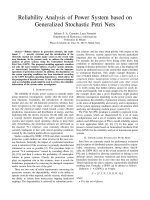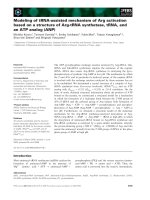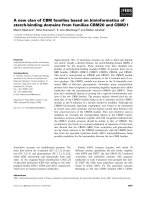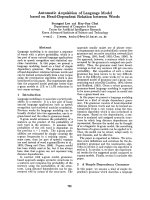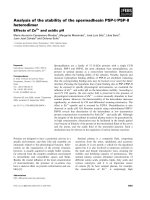Analysis of milling stability based on cutting force signal processing
Bạn đang xem bản rút gọn của tài liệu. Xem và tải ngay bản đầy đủ của tài liệu tại đây (2.9 MB, 86 trang )
國國國國國國國國
國國國國國 國國國國
國國
國國國 M 10 4 0 3 8 0 2
國國國國國國國國國國國國國國國
Analysis of Milling Stability Based on
Cutting Force Signal Processing
(Draft)
國國國國Tran Minh Quang
國國國國國Chun-Hui Chung, Meng -Kun Liu
國國國國 國國國 國 國國 國國國
國國
國國國國國國國國國國國國國國國國國國國國國國國國國國國國國國國
國國國國國國國國國國國國國國國國國國國國國國國國國國國國國國國國國國
國國國國國國國國國國國國國國國國國國國國國國國國國國國國國國國國國國
國國國國國國國國國國國國國國國國國國國國國國國國國國國國國國國國國國
國國國國國國國國國國國國國國國國國國國國國國國國國國國國國國國國國國
國國國國國國國國國國國國國國國國國國國國國國國國國國國國國國國國國國
國國國國國國國國國國國國國國國國國國國國國國國國國國國國國國國國國國
國國國國國國國國國國國國國國國國國國國國國國國國國國國國國國國國國國
國國國國國國國國-國國國國國國國國國國國國國國國國國國國國國國國國國
國國國國國國國國國國國國國國國國國國國國國國國國國國國國國國國國國國
國國國國國國國國國國國國國國國國國國國國國國國國國國國國國國國國國國
國國國國國國國國國國國國國國國國國國國國國國國國國國國國國國國國國國 國國國國國國國國國國國國國 standard
deviation 國國國國國國國國國國國國
國國國國國國國國國國國國國國國國國國國國國國國國國國國國國國國國國國 國國國國國國國國國國國國國國國國
國國國國國國國國國國國國國國國國國國國國國國國國國國國國-國國國
i
Abstract
The milling operation is the most common form of machining. Because the action of
each cutting edge and workpiece is intermittent and periodical, the chip thickness varies
periodically. This could lead to self-excited vibrations and unstable cutting which is called
chatter vibration. Chatter causes machining instability and reduces productivity in the metal
cutting process. It has negative effects on the surface finish, dimensional accuracy, tool life
and machine life. Chatter identification is therefore necessary to control, prevent, or
eliminate chatter and to identify the stable machining condition. A dynamic cutting force
model of the end-milling process with tool runout error was established in this research to
understand the underlying mechanism of chatter. The accuracy of the cutting force model in
both time and frequency domains was evaluated by comparing to experimental force
signals. Time- frequency analysis approaches, specifically short time Fourier transform,
continuous wavelet transform and Hilbert-Huang transform, were utilized to give an utterly
different perspective of chatter from the conventional Fourier spectrum which is insufficient
in analyzing the signals of rich nonlinear characteristics. By comparing the simulation with
experimental result, chatter frequency was found to consist of two major components,
frequency modulation alongside tooth passing frequency caused by the increased tool
runout error and the non-stationary high frequency from the regenerative vibration.
Moreover, dimensionless chatter indicators, defined by the standard deviation and energy
ratio of the specific intrinsic mode function, could identify the occurrence of chatter
effectively. The analysis result was then validated by the workpiece surface topography,
surface roughness and the stability lobe diagram.
Keywords: Milling process, Chatter detection, Time-frequency analysis, Wavelet
transform, Hilbert Huang transform.
ii
Acknowledgement
I would like to thank all the people who helped me to finish this thesis. First of all, I
would like to express my deep gratitude to my academic advisors: Professor. Chun-Hui
Chung and Professor. Meng-Kun Liu for their valuable guidance, encouragement, and
support throughout my work towards this thesis. Without their help and guidance, this work
would not be possible.
I also would like to thank Mr. Yi-Wen Qui who provided his experimental data
which was used to verify my methodology in this thesis. I would like to thank all of my
labmates who have supported me a lot with laboratory facilities so that I could conduct my
experiments. I thank my friends who always give me encouragements and supports during
my research.
Finally, I would like to thank my parents who always give me love, encouragement,
and support throughout my life. I would specially thank my wife and my son for their
patience and support during my study. I am very grateful for their love.
iii
Nomenclature
radial and tangential edge
db
discretized axial depth of cut (mm)
Kne ,
Kte
dF
differential radial cutting force (N)
Nt
number of flutes
r
edge radius (mm)
n
dFt
differential tangential cutting force
(N)
differential cutting force in x-direction
dF
(N)
x
differential cutting force in y direction
dFy
(N)
x, y
z
coefficients (N/mm)
displacement in x and y directions
(mm)
absolute value of the distance from
the end (mm)
ft
feed per tooth (mm/flute)
helix angle (deg)
Fs
sampling rate frequency (Hz)
immersion angle (deg)
Fsi
simulated cutting force (N)
e
exit angle (deg)
Fex
experimental cutting force (N)
s
start angle (deg)
b
axial depth of cut (mm)
c
chatter frequency (rad/s)
h
instantaneous chip thickness (mm)
spindle speed (rpm)
Ks
specific cutting force coefficient (N)
position angle (deg)
cutting force angle (deg)
runout of cutting edge (mm)
time for one rotation (sec)
K n , Kt
radial and tangential cutting
coefficients (N/mm2)
iv
Contents
國 國 ..........................................................................................................................................i
Abstract ..................................................................................................................................ii
Acknowledgement ................................................................................................................. iii
Nomenclature..........................................................................................................................iv
Contents ...................................................................................................................................
v
Chapter
1
................................................................................................................................ 1
Introduction............................................................................................................................
1
1.1.
Background ........................................................................................................... 1
1.2.
Objective and Scope .............................................................................................. 2
1.3.
Outlines and Contribution of the Chapters ............................................................ 3
Chapter 2 ................................................................................................................................
4
Literature Review ..................................................................................................................
4
2.1. Chatter Vibrations in Milling ........................................................................................ 4
2.2. Signal Analysis Approaches ......................................................................................... 6
Chapter 3 ..............................................................................................................................
10
Dynamic Cutting Force Model ...........................................................................................
10
3.1. Regenerative Chatter Model ....................................................................................... 10
3.2. Dynamic Cutting Force Model ................................................................................... 15
Chapter 4 ..............................................................................................................................
17
Experimental Setup and Model Verification ....................................................................
17
4.1. Overview and Aim ...................................................................................................... 17
4.2. Experimental Setup ..................................................................................................... 17
4.2.1. Machine, Cutter and Workpiece........................................................................... 17
4.2.2. Cutting Force Measurement Equipment............................................................... 19
4.2.3. Surface Topography Measurement Equipment .................................................... 20
4.2.4. Surface Roughness Measurement Equipment ...................................................... 20
4.3. Cutting Force Coefficients .......................................................................................... 21
4. 4. Experimental Design Parameters ............................................................................... 25
4.5. Tool Tip Dynamics ..................................................................................................... 27
4.5.1. Impact Testing ...................................................................................................... 27
4.5.2. Modal Analysis..................................................................................................... 27
4.5.3. Stability Lobe Diagram ........................................................................................ 31
4.6. Simulation and Experimental Results ......................................................................... 33
Chapter 5 .............................................................................................................................. 36
Chatter Detection Methodology ......................................................................................... 36
5.1 Short-Time Fourier Transform Analysis...................................................................... 36
5.2. Continuous Wavelet Transform Analysis ................................................................... 38
5.3. Time-Frequency Analysis Based on HHT .................................................................. 41
5.3.1. Chatter Detection Methodology ........................................................................... 41
5.3.2. Results and Discussions ....................................................................................... 44
5.3.3. Dimensionless Indexes for Chatter Identification ................................................ 50
5.3.4. Method Verification ............................................................................................. 51
5.4. Chatter Identification in Small Size of End Mill ........................................................ 54
5.4.1. Overview and Aim ............................................................................................... 54
5.4.2 Experimental Setup ............................................................................................... 54
5.4.3. Chatter Identification by Time-Frequency Analysis ............................................ 57
Chapter 6 .............................................................................................................................. 60
Conclusions and Future Works .......................................................................................... 60
6.1. Conclusions ................................................................................................................. 60
6.2. Future Works............................................................................................................... 60
Bibliography ......................................................................................................................... 61
vii
List of Figures
Figure 2.1 Milling regenerative chatter ................................................................................... 4
Figure 2.2 Stability lobe diagram ............................................................................................ 6
Figure 2.3 Time-frequency resolution of STFT [9] ................................................................. 8
Figure 3.1 The model of helical end mill geometry .............................................................. 10
Figure 3.2 Dynamic cutting force model ............................................................................... 11
Figure 3.3 Flow chart of dynamic cutting force .................................................................... 16
Figure 4.1 The three- axis CNC milling machine at NTUST ................................................ 18
Figure 4.2 A carbide end mill ................................................................................................ 18
Figure 4.3 Kistler Dynamometer ........................................................................................... 19
Figure 4.4 Experimental setup ............................................................................................... 19
Figure 4.5 Olympus BX51 at NUTST ................................................................................... 20
Figure 4.6 A Mitutoyo portable surface roughness tester...................................................... 21
Figure 4.7 The modeling of slot milling ................................................................................ 21
Figure 4.8 Measured cutting forced signal at feed rate of 0.03 mm/tooth in (a) x direction
and (b) y direction.................................................................................................................. 23
Figure 4.9 Relationship between feet per tooth and mean force ........................................... 25
Figure 4.10 Setup of the impact testing ................................................................................. 27
Figure 4.11 Relative frequency response in x direction ........................................................ 28
Figure 4.12 Relative frequency response in y direction ........................................................ 29
Figure 4.13 Direct FRF in x direction .....................................................................................
31
Figure 4.14 Direct FRF in y direction .....................................................................................
32
Figure 4.15 Stability lobe diagram and experimental design parameters .............................. 33
viii
viii
Figure 4.16 Cutting force in (a) x direction and (b) y direction at spindle speed of 1500 rpm
and 1.4 mm depth of cut ........................................................................................................
34
Figure 4.17 Cutting force in x direction at spindle speed of 5250 rpm when (a) DOC =
0.8mm (b) DOC = 1.4mm ..................................................................................................... 35
Figure 4.18 Fourier spectrum of the force signals at spindle speed of (a) 5250 rpm, DOC=
0.8 mm and (b) 5250 rpm, DOC =1.4 mm ............................................................................ 35
Figure 5.1 Hanning window ................................................................................................. 36
Figure 5.2 Short time Fourier transform by Hanning window at spindle speed of 5250 rpm,
DOC = 0.8 mm (a) Simulation and (b) experimental force signal ........................................
37
Figure 5.3 Short time Fourier transform by Hanning window at spindle speed of 5250 rpm,
DOC = 1.4 mm (a) Simulation and (b) experimental force signal ........................................
37
Figure 5.4 Morlet Wavelet..................................................................................................... 39
Figure 5.5 Continuous Wavelet Transform 2-D in case of spindle speed of 5250 rpm and 0.8
mm depth of cut .....................................................................................................................
40
Figure 5.6 Continuous Wavelet Transform 2-D in case of spindle speed of 5250 rpm and 1.4
mm depth of cut .....................................................................................................................
40
Figure 5.7 Flow chart of the chatter identification method ................................................... 41
Figure 5.8 Cutting force signal .............................................................................................. 42
Figure 5.9 Ensemble empirical mode decomposition............................................................ 43
Figure 5.10 The first eight IMFs of the filtered signal at spindle speed of 5250 rpm with 0.8
mm depth of cut .....................................................................................................................
45
Figure 5.11 The first eight IMFs of the filtered signal at spindle speed of 5250 rpm with 1.4
ix
mm depth of cut .....................................................................................................................
46
Figure 5.12 Instantaneous frequency of IMFs at spindle speed of (a) 5250 rpm, DOC= 0.8
mm (stable condition) and (b) 5250 rpm, DOC =1.4 mm (unstable condition) ....................
48
x
Figure 5.13 Hilbert-Huang spectrum of IMF2 at (a) stable condition and (b) unstable
condition ................................................................................................................................
49
Figure 5.14 Stability lobe diagram and the stability determined by proposed method ......... 52
Figure 5.15 Microscopic of the surface machined with different spindle speed and constant
depth of cut of 1.4 m ..............................................................................................................
52
Figure 5.16 Five-axis CNC milling machine......................................................................... 55
Figure 5.17 A carbide end mill .............................................................................................. 56
Figure 5.18 Experimental setup ............................................................................................. 56
Figure 5.19 Machined surface topography ......................................................................... 59
xi
List of Tables
Table 4-1 Machine features ................................................................................................... 18
Table 4-2 Parameters of Tool ................................................................................................ 19
Table 4-3 Cutting parameters for cutting force coefficients ..................................................
22
Table 4-4 Average cutting forces .......................................................................................... 23
Table 4-5 Specific cutting force coefficients ......................................................................... 25
Table 4-6 Experimental design parameters ......................................................................... 26
Table 4-7 Model parameters in x direction............................................................................ 30
Table 4-8 Model parameters in y direction............................................................................ 30
Table 5-1 IMF Property of force signal at spindle speed of 5250 rpm.................................. 47
Table 5-2 The energy ratio values of IMF2s ......................................................................... 50
Table 5-3 The standard deviation values of IMF2s ............................................................... 51
Table 5-4 Surface roughness measured along the feed direction at different cutting
conditions...............................................................................................................................
53
Table 5-5 Machine’s features ................................................................................................ 55
Table 5-6 Parameters of Tool ................................................................................................ 56
Table 5-7 Experimental design parameters ......................................................................... 57
Table 5-8 The standard deviation values of IMF2s ............................................................... 58
Table 5-9 The energy ratio values of IMF2s ......................................................................... 58
xi
i
Chapter 1
Introduction
1.1. Background
The milling operation known as a cutting process is the most common form of
machining, in which a rotating tool with defined cutting edges is moved relative to a
workpiece in order to remove material [1]. Because the action of each cutting edge is not
continuous and cuts less than half of the tooth revolution, the chip thickness varies
periodically as that tooth enters and exists the cut. As a result, an impact is produced when
the edge touches the workpiece. In addition, the tool could vibrate because of the variation
of chip thickness [2]. There are two kinds of vibration: (1) forced vibrations caused by the
periodic cutting forces acting on the machine structure and (2) chatter vibration which is
self- excited machining behavior. Machine tool chatter causes machining instability. It
results in noise, poor surface roughness, increase of tool wear, reduction of tool life and
productivity in machining [3, 4]. This phenomenon should be detected and avoided during
the cutting process in order to avoid machining instability and to improve the productivity.
Regenerative chatter in milling is because the previous and current cuts are out of phase.
The instantaneous chip thickness is variable, it governs the cutting force which, in turn,
affects subsequent tool vibrations [2]. Therefore, dynamic cutting force model plays an
important role in analyzing and predicting chatter vibration. The accurate model could be
used to analyze the machining process and optimize the cutting parameter.
A stability lobe diagram based on regenerative chatter theory is generally a simple
and useful way to predict and control chatter [2-4]. This approach was however based on
the restrictive assumption that the dynamics of spindle-tool system has not changed over the
spindle speed range [5]. The stability lobe diagram may inevitably misinterpret the
important attributes of the machining processes which in fact always contain rich nonlinear
characteristics [6, 7]. Both time and frequency responses hence have to be monitored
simultaneously.
1
In order to distinguish whether chatter occurred, some machining process signals
have to be measured by using different techniques such as in-process real-time techniques
based on force and displacement signals or off-line machined surface characterization [8].
The Fourier transform (FT) that can transform time domain signal into frequency domain
signal is suitable for the stationary signal process, especially when the feature components
of signals are obvious in magnitude. For non-stationary signal, the wavelet transform (WT)
known as a flexible method is suitable for detection of a sudden frequency change in a
signal [9]. Another time-frequency approach, Hilbert-Huang transform (HHT) has been
widely used to investigate machining vibration. This method is a powerful tool for
time -frequency analysis of nonlinear and non-stationary signals due to performing a
time adaptive decomposition operation on signals and no uncertainty principle limitation
on time or frequency resolution [10].
A dynamic cutting force model with tool runout error was established in this
research to fit the cutting force signal properly and analyze the chatter identification. Timefrequency analysis approaches based on cutting force signal, specifically short time Fourier
transform, continuous wavelet transform and Hilbert-Huang transform, were utilized to give
an utterly different perspective of chatter from the conventional Fourier spectrum which is
insufficient in analyzing the signals of rich nonlinear characteristics.
1.2. Objective and Scope
The stability of the process was investigated by the time-frequency analysis. All three
of short time Fourier transform, WT and HHT approaches were used for processing the
cutting force signals. The difference between stable and unstable conditions was clearly
distinguished from the analysis. Most of the energy concentrated at tooth passing frequency
in stable cutting condition, while a large amount of energy emerged at high frequency when
chatter occurs. In order to detect chatter efficiently whether it is highly nonlinear behavior
or not, dimensionless indexes such as standard deviation and energy ratio of intrinsic mode
functions (IMF) of the cutting force signals were proposed and studied in this research.
1.3. Outlines and Contribution of the Chapters
The thesis is organized into six chapters as follows. Chapter 1 introduces background,
objectives, methods, and contributions of the present work. A literature review related to the
research is described in Chapter 2. In chapter 3, dynamic cutting force model regarding
runout error is presented. Model verification is provided in chapter 4 in which experimental
design parameters, tool tip dynamics, and comparison of simulated and experimental results
are presented. In chapter 5, chatter detection methodologies including short time Fourier
transform, continuous wavelet transform analysis and time-frequency analysis based on
HHT are given. The results and discussions are also presented in this chapter. Finally, the
summarizations and future works of this thesis are carried out in chapter 6.
Chapter 2
Literature Review
2.1. Chatter Vibrations in Milling
Regenerative chatter in milling is self-excited vibration. This mechanism is
associated with the phase shift between vibration waves on both sides of the chip left by
previous cutting tooth and current tooth. This phenomenon was firstly explained by Tlusty
and Polacek (1963), and then by Schmitz and Smith, S (2008); Altintas and Yusuf (2012).
Figure 2.1 shows that the wavy surface left by tooth 1 is removed by tooth 2 and so on. This
gain provides a feedback mechanism because the instantaneous chip thickness depends on
both current vibration and surface left by the previous tooth passing. When the vibrations
from one cutting edge to the next are in phase, the chip thickness varies as the cycloidal
path. This causes forced vibration only, and the cutting is stable. On the other hand, the out
of phase shows a less favorable phase relationship, chip thickness variation is significant. It
results in chatter vibration in milling. When chatter occurs, it could cause negative effects
on the process such as producing noise, poor surface roughness, increasing tool wear,
reducing tool life and productivity [2-4]. Chatter prediction is therefore critically important
for determining stable cutting parameters such as spindle speed, depth of cut (DOC), and
feed rate.
Figure 2.1 Milling regenerative chatter
Dynamic cutting force model has played an important role in analyzing and
predicting chatter vibration. The accurate model could be used to analyze the machining
process and optimize the cutting parameter. The orthogonal chatter theory was more
complicated to apply in the milling process due to the changing thickness direction, the
rotating cutting force, and the intermittent cutting periods [3, 4]. The engagement between
cutter and workpiece was referred to the instantaneous chip thickness and was considered as
a function of cutting force in the cutting force mechanism. The force modeling for the
cutting process was first presented
by Martellotti [11], in which the chip thickness was calculated by a simple expression of
h ft sin . A mechanistic model for the force system in end milling was developed by
Kline et al. [12]. This model is based on chip load, cut geometry, and the relationship
between cutting forces and chip load, the uncut chip thickness was reportedly proportional
to the cutting force. Tsai proposed a predictive force model in end-milling process
based on geometrical analysis [13]. A generalized geometric model of milling cutters was
reported in [14]. During milling operation, tool runout has negative effects on the
performance of the cutting operations. There are some possibilities leading to cutter runout
[2]: axis of rotation errors of the spindle, an offset between the holder centerline and spindle
axis of rotation an offset between the tool centerline and holder centerline, and radii
variation between cutter teeth. The average chip thickness was increased corresponding to
the presence of runout for those teeth actually engaged in the cut, the effects of runout errors
on dynamic chip thickness were investigated to improve the accuracy of the model [15, 16].
The basics of chatter vibration in orthogonal cutting operations described by an accurate
model were proposed by Tobias [17].
A stability lobe diagram based on regenerative chatter theory is generally a
prevailing method to predict and control chatter. Figure 2.2 represents an example of
stability lobe diagram. The diagram was divided into stable and unstable zones by a
stability boundary generated by a series of intersected stability lobes [2, 3]. Stable
machining conditions with higher material removal rates could be thus achieved by using
this method [18, 19]. The development of stability lobe diagram was however based on the
restrictive assumption that the dynamics of spindle-tool system has not changed over the
spindle speed range [5].
Figure 2.2 Stability lobe diagram [2]
The stability lobe diagram may inevitably misinterpret the important attributes of the
machining processes which in fact always contain rich nonlinear characteristics [6, 7]. Both
time and frequency responses hence have to be monitored simultaneously.
2.2. Signal Analysis Approaches
The methods used generally for evaluating the vibration signals involved the
transformation of the cutting force signals from time to frequency domain are Fast Fourier
Transform (FFT), Short-Time Fourier Transform (STFT), and Continuous Wavelet
Transform (CWT). Through these methods, it was possible to view properties or
characteristic
information of the cutting process hidden in the time domain [20]. Fourier transform (FT)
transforms the signal f (t ) from the time domain to the frequency domain fˆ
( )
in Eq. 2-1.
fˆ ( )
described
f (t )e
dt
j t
(2-1)
Fourier transform considered as the basis of modern signal processing is well known
to process the stationary signals, especially when the feature components of signals are
obvious in magnitude [21, 22]. There are a lot of studies using FFT to identify chatter
vibration in metal cutting. Chatter frequencies are often high non-integer multiples of
frequency with the higher magnitudes appeared in the Fourier spectrum, which was
analyzed and shown in the previous literature [7, 23]. The Fourier-based methods are
nonetheless based on the assumption that the analyzed signal is stationary in the time
domain. The globally inclusive of information makes it difficult to provide any information
about individual frequency event of the signal. It is accordingly not suitable for many nonstationary systems when their transient responses are analyzed.
Previous research was reported that the proper method for processing time-varying
non-stationary signal is time–frequency analysis, which includes STFT, Wigner–Ville
distribution, Gabor transform, WT, wavelet packet transform, and HHT. They are effective
time–frequency analysis methods. To overcome this limitation of FFT, Gabor introduced a
sliding window function to the FT and obtained a localized time–frequency [9]. Equation 22 represents the resultant transform named short-time Fourier transform.
f (t )u
,
dt
f (t )(t u)e jt
(2-2)
�
where u is position parameter of wavelet function. The frequency resolution 國
2
and
time
2
resolution � shown in Fig. 2.3 are constant for both time and frequency. According to Fig.
��
2.3, it can be concluded that high resolution both in frequency and time cannot be attained at
the same time (The uncertainty principle). This is one of the most restrictive in STFT.
Figure 2.3 Time-frequency resolution of STFT [9]
Continuous and discrete wavelet transform (WT) were recognized by many
researchers as flexible and effective tools for processing both stationary and non-stationary
signals, particularly in machining [25]. Wavelet is advantageous for the analysis of nonstationary time series data arisen from metal cutting according to Kunpeng et al. [26]
because it possesses better resolution capabilities in both time and frequency domains.
Decomposed signals were usually obtained by choosing proper wavelet coefficients for
feature extraction in order to detect chatter [27]. The sudden amplitude change of
decomposed vibration signals could be considered as a valid evidence to identify chatter
[7]. By applying FT to the decomposed signals, their Fourier spectrum revealed clear
presence of chatter [28]. Support vector machine and wavelet transform were used by Peng
et al. [29] to detect chatter. They reported that once chatter occurs, the corresponding
vibration signal generally exhibited non- stationarity, and the frequency components of the
signal varied over time. The behavior of the detail coefficients from WT was used to
determine the presence of chatter [30]. Nevertheless, WT is still difficult to determine the
suitable wavelet function and decomposition levels to carry out the chatter fingerprint. In
addition, the decomposed signal might be distorted and result in limited accuracy.
Hilbert-Huang transform (HHT) has recently become a superior tool to investigate
machining vibration. This method is a powerful tool for time-frequency analysis of
nonlinear and non-stationary signals due to a time adaptive decomposition operation on the
signals. It
is moreover not limited by uncertainty principle because of its precise time and frequency
resolutions [10, 31]. The complex time series signals were decomposed into a set of intrinsic
mode functions (IMFs) which represent simple oscillatory modes [32]. The instantaneous
frequency (IF) could be consequently obtained by applying Hilbert transform to each IMF.
Fourier spectrum of IMFs and the marginal spectrum obtained by HHT could be used to
observe the main frequencies of the signal among those moments with chatter, as reported
by Wei et al. [6] and Peng et al. [33]. The approach, however, was still burdensome to select
IMFs that contain rich chatter information for analyzing signals. Wavelet packets were
utilized by Cao et al. [34] to decompose the signal into a set of narrow bands in order to
enhance the result of HHT. The dimensionless chatter indicators defined by the mean value
and standard deviation of Hilbert-Huang spectrum were reported as effective tools for
chatter detection. This method is nevertheless troublesome to determine the suitable wavelet
decomposition level and to select optimal mother wavelet. The nonlinear dimensionless
indicators, complexity and power spectral entropy were utilized as chatter indicators after
being processed with ensemble empirical mode decomposition (EEMD) [35].
A dynamic cutting force model with tool runout error in the end-milling process was
proposed to generate the force signals in this study. The stability of the process was then
investigated by the time-frequency analysis. All three of STFT, WT and HHT were used for
processing the cutting force signals. The difference between stable and unstable conditions
was clearly distinguished from the analysis. Most of the energy concentrated at tooth
passing frequency in stable cutting condition, while a large amount of energy emerged at
high frequency when chatter occurs. The standard deviation and energy ratio of IMFs were
defined as dimensionless indicators for detecting the presence of chatter effectively, even
though the cutting forces are known as non-stationary signals and changed in different
states. The proposed method was validated by the stability lobe diagram created by impact
testing and the machined surface topography along with surface roughness.
